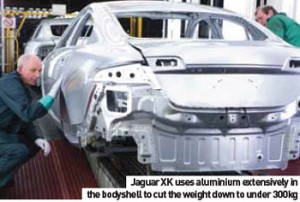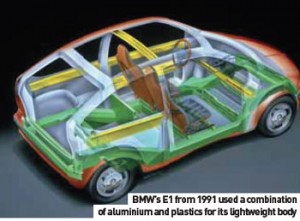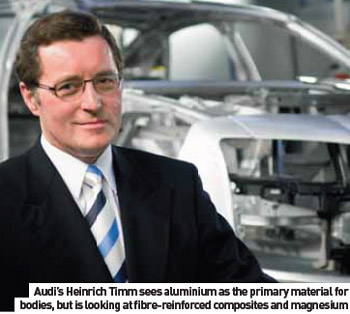Aluminium may be the most abundant metal in the Earth’s crust, but it still has a long way to go if it is to replace steel as the default material for car body construction. However, some applications engineers believe that the benefits of a material density one-third that of steel more than outweighs the disadvantages of higher raw material cost and comparatively low strength, stiffness and formability.
Jaguar has long been a strong advocate of aluminium. The XJ saloon of 2002 was the company’s first all-alloy car, and the material has featured heavily in all later models, including the new XK and the recently-launched, all-new 2009 XJ model. Presented with the opportunity of cutting the mass of the XK’s body-in-white (BIW) by 40% in comparison to the same vehicle made of steel, served to create the impetus needed to carry through aluminium monocoque construction for the XK coupé and convertible; the latter has a shell weighing only 287kg.
The XK also makes more use of aluminium castings than the XJ in high load bearing areas, such as engine and suspension mounting points. Excluding those in the doors, there are 20 castings, the majority of these being highpressure diecast.
Could the XK have been made just as light using the latest advanced high strength steels? Mark White, Chief Technical Specialist for body-in-white, Jaguar and Land Rover: “You can get a weight saving with high strength steel (HSS) but it’s a small saving. Despite going from almost no HSS content in the mid-1990s to well over 50% in recent offerings, most of the cars and their BIW have increased in weight.”
Trading strength against weight will always result in compromise but, White says, the benefits of using HSS are not universal. “About 15 to 20% of the BIW are strengthdominated parts; they’re the only real area where you can save weight with HSS.”
Aluminium has low density in its favour, but its elastic modulus of 69 GPa is typically only one-third that of steel.
In the most basic case, the linear stiffness of an aluminium part can equal that of steel by raising material thickness by 50%, with the added benefit of returning virtually the same weight saving. Cost is another matter, but it cannot be ignored when considering HSS: it is more expensive to buy and to process than ordinary forming steels. Elevated yield strengths can reduce the suitability of the material for complex, deep-drawn shapes, one of the criticisms commonly leveled at aluminium. There are also issues with joining different steel grades, specifically with weld quality, this due to the dissimilar carbon content of steel varieties. In July 2006, Ford (which owned the Jaguar brand at the time) outlined its strategies to cut emissions and boost fuel economy, the company starting research into a new generation of lightweight premium vehicles. This was the first step, according to White: “We learned a vast amount from XJ that we applied to XK, and would apply to any other future products that we might do.
“Most of the learning was about production and quality maturation rather than technology. I think we knew most of the technology when we started XJ. We didn’t have to invent many things on the run, likewise the XK. We can apply that learning across Jaguar and Land Rover, bearing in mind the decision by Ratan Tata (chairman of JLR’s present owner) to encourage full aluminium usage across all company brands.”
Jaguar continues to review new manufacturing techniques for lightweight structures, and also new materials and production methods. Aluminium tailored blanks, first used in the automotive sector in 2003 for forming the wheelarches of the Lamborghini Gallardo, are not used by Jaguar due to concerns surrounding integrity and performance of the welds. Instead, the carmaker is investigating tailor-rolled blanks, primarily to increase local strength in areas of greater stress. The process uses profiled rollers to produce varying section thicknesses across a sheet of homogeneous material.
Jaguar has also looked at a multi-alloy technology from Novelis, formed in 2005 as a spin-off from Alcan. Novelis, which supplies 150kg of 5000 and 6000 grade sheet for every XK, has developed a new method of casting ingots. Dubbed ‘fusion technology’, it allows several grades of material to be cast simultaneously to form a single ingot: a big improvement, it says, over the cladding method used for the past 60 years.
Complex process control prevents surface oxidation of the different grades, resulting in better intermolecular bonding at interfaces. The ingot is then rolled into sheet, including gauges commonly used for automotive. As-rolled thickness of the outer layers can be between five and 15% of gauge.
The result is a material where core strength can be adjusted to offer increased formability while retaining high strength at the outer fibres, combined with a quality surface finish.
Samples have been supplied to OEMs, which are currently conducting trials with the new material. One application identified by Novelis is outer panels for closures, where hemming has traditionally been a problem with aluminium.
 It claims panel gaps can be tighter and more consistent because of better forming – especially on corners, and with improved aesthetics.
It claims panel gaps can be tighter and more consistent because of better forming – especially on corners, and with improved aesthetics.
Sheet made this way will cost more, but Novelis believes that the automotive industry will be a big market for fusion products. Michael Bull, Director of Technology at the Auto Division, says: “Price is obviously an issue, but the way we look at it is that there will be great pressure to light-weight vehicles. Fusion adds value throughout the supply chain: down-gauging, robustness at high volume and ease of forming are all key attributes. Taking an outer panel from 1.1 to 0.8mm considerably alters the business case.”
Yet the business case at present is very much centered around a targeted use of aluminium. Mark White cites the BMW 5 Series as an example where aluminium used in the front end of an otherwise steel monocoque has reduced overall weight of the BIW. Similarly, the new Audi TT couples a development of the aluminium space frame, first seen in the A8, with steel. The resulting bodyshell weighs 206kg, with aluminium accounting for 140kg.
This future view for aluminium is echoed at Novelis. John Gardner, European Vice-President, Communications, says: “Ten years ago, aluminium-intensive vehicles were the Holy Grail; we were looking at a (limited) number of them, and that was it. Our view today is that there will be niche allalloy cars like the Audi A8, Jaguar XJ and others, and that aluminium for these applications will work very well. But for mass volume cars, I’m not sure that the market is willing to accept it. But what we do want, and what we are seeing the growth in, are multi-metal cars.”
Gardner adds: “Clearly cost is a very big driver. We’re working very hard with our customers, and I think the success we’ve had with them is where they haven’t just looked at the initial material cost, but at the cost of the whole system. There is now a much better understanding of the total value that you can add by lightweighting.”
Total value includes environmental gains. The need to reduce CO2 emissions and fuel consumption will put increasing pressure on engineers to make cars lighter. In so doing, the trend towards downsizing can accelerate.
Jaguar’s reintroduction of six-cylinder engines into the XJ is attributed to the aluminium body. Lighter weight also reaps benefits in dynamics, as White explains: “If you look at the performance of the XK, relative to its competitors, we get away with a smaller engine and less power. But the customer benefits when they’re not using all of that power in everyday use, in terms of fuel economy and emissions. And there’s agility: never underestimate the effect of reduced weight on agility.”
 But, says White, aluminium also has competition.
But, says White, aluminium also has competition.
“Aluminium is the material of choice to get us the significant weight saving we need on products like the XJ and XK – the very large cars. The people who worked on these programmes are very good body engineers, but I want to foster the ability to not just look at aluminium but also at magnesium, plastics and HSS – and to do it because it’s the right reason.”
BMW has been actively looking into increasing its material variety, with its 6 Series coupé mirroring the aluminium front/steel BIW of the 5 Series, but adding aluminium bonnet and doors, plastic front wings and a composite boot lid.
Of course, what all these cars have in common is the fact they are premium vehicles. This makes recovery of any additional material cost that much easier over B- or C-segment vehicles. Larger cars permit the use of larger sections, an effective way of stiffening the structure instead of using thicker sheet. So BMW’s 3 Series, a more recent design than the 5 or 6 Series, does not use the mixed metal approach for BIW, instead relying on HSS to return mass reductions and increased torsional stiffness over its predecessor.
BMW’s experience of lightweight economical cars is not confined to its latest Efficient Dynamics programme. As far back as 1991, the carmaker showed an advanced electric car, the E1. The company’s first all-electric car was a fullyfledged saloon, offering space for four passengers and luggage. As an early example of lightweight construction, the body was a combination of extrusion-pressed aluminium profiles, with the outer skin made of plastic and aluminium.
Audi accelerates its aluminium expertise
Audi has built more than 550,000 vehicles with an allaluminium body, not including the approximately 9,000 Lamborghinis produced since the German carmaker took over the Italian supercar builder. No other manufacturer in the world comes close in terms of aluminium vehicle numbers - or their diversity.
The Audi Safety Frame (ASF) technology has been a great success story, with the company increasing its lead step by step: in alloys, in reducing the quantity of parts used and in production efficiency. Numerous innovations in development and production have raised the level of automation from 25 to over 80%, which is nearly equal to that of steel body construction.
In fabrication, traditional spot welding is being replaced by joining methods that include punch riveting, bonding or laser-MIG hybrid welding. In the TT and the R8, selftapping screws are used to join many of the components.
Another innovation is the invisible laser-welded seam on the roof of the TT; the same process is used by Volkswagen for the steel roof of the Golf.
The second-generation of the A8, R8, TT Coupé and Roadster sports cars serve to highlight the evolution of the ASF technology. The superstructure of the current A8 weighs 218kg, while the aluminium body of the R8, whose co-supporting engine frame is made of ultra-light magnesium, tips the scales at 210kg.
The TT Coupé and Roadster bodies weigh 206kg and 251kg respectively, while the TT ‘family’ also features an additional innovation. To ideally balance the axle loads between the front and rear, Audi has developed an innovative hybrid construction for its compact sports cars, with most of the body made of aluminium, and steel used in the rear.
Depending on the model, the kerb weight of the TT has been reduced by between 20 and 90kg compared to the previous model which had an all-steel body. At the same time, the static torsional rigidity of the Coupé has been increased by 50%, while the Roadster has increased by 100%.
The ASF provides the foundation for precise handling and a high level of passive safety. A lighter car has to dissipate less kinetic energy and also causes less damage to others involved in an accident. The lightweight design combines chassis responsiveness and efficiency in typical Audi fashion.
Audi established a special Aluminium Centre in 1994 at its Neckarsulm facility for development, production planning and quality assurance. The Aluminium and Lightweight Design Centre experiments with high-strength steels, tailored blanks, fibre-reinforced plastics and magnesium.
 Heinrich Timm, head of the Aluminium and Lightweight Design Centre, says: “Aluminium remains the primary material, but we are intensively investigating the other materials, with our primary focus on fibre-reinforced composites.”
Heinrich Timm, head of the Aluminium and Lightweight Design Centre, says: “Aluminium remains the primary material, but we are intensively investigating the other materials, with our primary focus on fibre-reinforced composites.”
The strategies defined by the 150 staff at the Aluminium and Lightweight Design Centre innovation foundry have already served as the basis for a series of patents in development and production. The European Patent Office named Audi “European Inventor of the Year 2008” for its achievements with the ASF technology.
Elsewhere, aluminium is making more of an impact in the lower market segments. Low intensity use at higher volumes is increasing sheet aluminium consumption, through the gradual substitution of steel in discrete parts such as closures. For example. the Renault Clio III has an aluminium bonnet, with the material also appearing in the doors for side impact protection.
It seems that the aluminium sector will continue to grow, but the material will feature more in economy cars using less of the world’s resources, instead of super sports cars bristling with power and technology that 10 years ago might have been expected to be the major aluminium adopters.


































